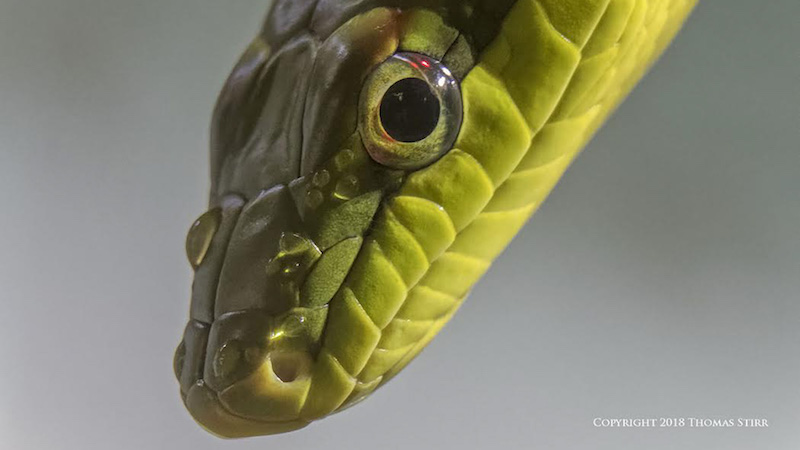Everyone has their own approach when it comes to zoo photography. My preference is to get in as tight as I can so I can capture the personality and details of a subject. During a recent visit to the Toronto Zoo I took a minimum of gear with me – a Nikon 1 J5 along with a 1 Nikon CX 70-300 mm f/4.5-5.6 zoom, and a 1 Nikon 30-110 mm f/3.8-5.6 zoom. I also packed a set of MOVO extension tubes and ended using the 20 mm tube for some of my images. All of the images in this article were shot hand-held in available light and are presented as 100% captures without any cropping at all.

The lighting on the snake in the above image initially caught my eye. I looked for a shooting angle that would give me a monochromatic background as well as deal with the smudges and dirt on the glass enclosure, as well as glare. It was shot at f/5.6, 1/25, ISO-3200 using a 1 Nikon 30-110mm f/3.8-5.6 at 66.4 mm (efov 179.3 mm). A 20 mm MOVO extension tube was used. As is the case with all of my photographs I used the PRIME noise reduction function in DxO PhotoLab to deal with noise.

This image of a tortoise drinking some water was shot with the 1 Nikon 70-300 mm f/4.5-5.6 zoom at 219.6 mm (efov 592.9 mm), f/5.6, 1/30, ISO-3200. I like applying the MicroContrast function in DxO PhotoLab to help bring out fine details in my images.

My wife and I love the orangutan exhibit and typically spend quite a bit of time there. On the day of our visit there was only one specimen in the display area. The above image was captured using the 1 Nikon CX 70-300 mm zoom at 300 mm 9efov 810mm), f/5.6, 1/40, ISO-3200.

The gibbon captured in the above photograph was up very close to the glass necessitating a shorter focal length of 70 mm (efov 189 mm) with my 1 Nikon CX 70-300 zoom. It was captured at f/5.6, 1/320, ISO-3200.

I had to shoot through thick, soiled glass to capture the tiger image above. It was taken with the 1 Nikon CX 70-300 mm zoom at 264 mm (efov 712.8 mm), f/5.6, 1/160, ISO-800.

The free-flying peacock pictured above was resting above the doorway to one of the pavilions, allowing me to shoot upwards towards it with trees as a background. The 1 Nikon CX 70-300 mm was used at a focal length of 234.5 mm (efov 633.2 mm), f/5.6, 1/1250, ISO-800.

The gorilla exhibit was extremely crowded as throngs of people were trying to see a mother gorilla with its two-week-old baby. There was no way for me to get in close enough with a decent shooting angle to capture an image, so I concentrated on a large, adult male gorilla instead. The image above was one of my better photographs of the day, capturing the gorilla as it was examining something it had picked off its face. The 1 Nikon CX 70-300 zoom was used at 300 mm (efov 810mm), f/5.6, 1/400, ISO-800.

We had a beautiful, clear blue sky the day of our visit which enabled me to frame the giraffe with a monochromatic background. One of the things that I really enjoy about this type of photography is being able to get a better view of the colouring and details of the animals. I had never noticed how the hairs on the back of a giraffe’s neck alternate colours. The image was captured with the 1 Nikon CX 70-300 mm at 228.9 mm (efov 618 mm), f/5.6, 1/800, ISO-160.

The hippos in the above image had just settled down for a nap when I grabbed this photograph. The angle of the sun helped to bring out the details in the hippo’s skin. I had my 1 Nikon CX 70-300 mm set at 257.7 mm (efov 695.8 mm), f/5.6, 1/250, ISO-160.

This image of a crayfish, along with the last two images in this article were all shot with the 1 Nikon 30-110 mm f/3.8-5.6 zoom lens and a MOVO 20 mm extension tube. As would be expected all were photographed through soiled glass enclosures. The crayfish image was shot using a focal length of 110 mm (efov 297 mm), f/5.6, 1/13, ISO-3200.

If my memory serves, the snake in the above image is an Emerald Tree Boa. It was captured using a focal length of 77.1 mm (efov 208.2), f/5.6, 1/20, ISO-3200.

I am unsure of the species of lizard in this last photograph. It was feeding up next to the glass which allowed me to get in very tight on its head. The image was captured using a focal length of 80.1 mm (efov 216.3 mm), f/5.6, 1/60, ISO-3200.
The next time you visit a zoo or other captive animal display you may want to experiment getting up close and personal with your images.
Article and all images are Copyright 2018 Thomas Stirr. All rights reserved. No use, duplication or adaptation of any kind is allowed without written consent. Mirrorlessons.com is the only approved user of this article. If you see this article reproduced anywhere else it is an unauthorized and illegal use. Posting comments on offending websites and calling out individuals who steal intellectual property is always appreciated!
